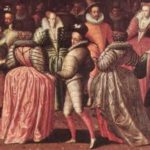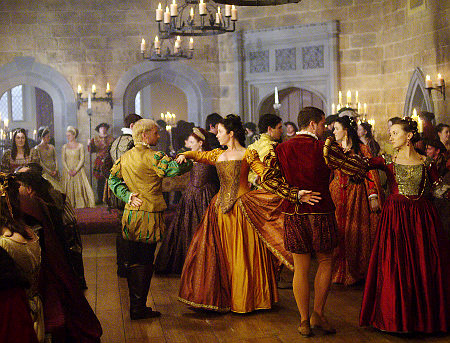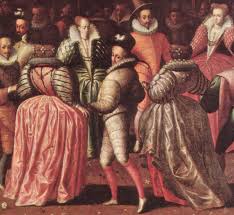Many simple country dances were performed by the Elizabethan nobility and these are detailed in the appropriate section below. It was impossible for many of these dances to be performed by the Lower Classes as many of the instruments used were large, such as the keyboard instruments or not suitable for outdoor use.

Elizabethan era Dance
During the Renaissance period, dance techniques changed with the change of fashion. The clothes worn in this era were large and baggy. The upper bodies of women were covered with tight-fitting corsets and tight lacing in case of men. The ruff also restricted head movements.
The dance, therefore, relied on mainly footwork and a display of enthusiastic energy. There were complicated footwork steps designed to match with the music. walking step, sitting step, stamping and sliding of the feet were different kinds of steps.

There were two basic categories of dance in the Renaissance era. The first was the simple kind of dance where men and women gathered up and danced in circles or lines. Many people could participate in these dances together. The pavan was one such dance.
The second category was a more complex dance and required the supervision of an expert. They needed much practice to be perfected and were usually performed in duets. They were usually performed for an audience.

The following list details and the dances specifically performed by the Elizabethan Upper Classes
- The Pavane dance or Elizabethan Pavan – A stately court processional dance where Elizabethan couples paraded around the hall lightly touching fingers. Pavane means peacock and the name of the dance derives from the sight of the trains of the women’s gowns trailing across the floor like a peacock’s tail. It comprised of a pattern of five steps, hence its alternative name ‘Cinque pas’
- The Cinque Pas meaning five steps, an alternative name for the Pavane
- The Galliard – A lively dance, originating from the fifteenth-century, which usually followed and complemented the Pavane
- Sinkapace – Another name for a Pavane
- The Almain – the Almain was one of the Elizabethan principle accompanied by keyboard instruments and lute music
- The Volt, Volte, la volta – Elizabethan court dance was the only dance which allowed the dancers to embrace closely. In this suggestive dance, the women were lifted high in the air by their male partner
- The Gavotte – Described by the Dancing Master Arbeau in 1588 it became known as ‘La Danse Classique’. Danced in couples in a circle to a medium tempo. Developed into a Kissing dance which probably accounts for its popularity!
- The Courant or Courante – Sophisticated, slow-moving dance which originated in France
- The Saraband – Another sophisticated, slow-moving dance which originated in France
- The Tourdion – Similar to the Galliard but a little more sedate
- Ballet – A formal and courtly Italian dance form established at the French court in the sixteenth century, It was originally danced both by courtiers but now danced by professionals
- Saltarella, Saltarello, Saltarello – a fast dance of Italian origin similar to the Galliard
- The Canary – a Spanish dance described as ‘gay but nevertheless strange and fantastic with a strong barbaric flavor’. Its popularity in France led to its importation into England
More Info On- Elizabethan Dances of the Lower Classes, Drama, England Music, Plays, Musical Instruments, Dancing and Music, Theatre Facts, Theatre History

